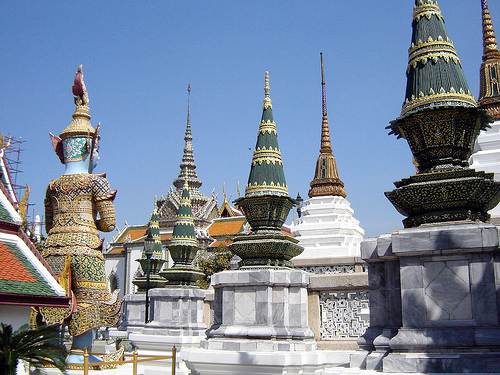I’ve never been to Thailand, but I’ve been to a few wats [Thai Buddhist temple]. Whether In Bodh Gaya, Lumbini, or LA—all places with Buddhist temples from all over the world—I’ve been especially taken by the elaborate, colorful structures that represent Thailand (actually the Thai temple in Lumbini is completely white in honor of the Buddha’s birth, but it’s equally impressive). However, the spiritual nourishment I’ve drawn from these places has nothing to do with my (in)ability to read them—I knew nothing about the function of a luk nimit (sacred stone ball), for example—but was simply a gift of their beauty.
While it’s true that the beauty of Thai temples can be quite powerful even when left unexplained, I’d trade a little exoticism for some informed wonder any day of the week. To this end Carol Stratton has written a short guidebook entitled What’s What in a Wat: Thai Buddhist Temples (Silkwork Books, February 2011, 104 pp., 132 illus.; $16:95 paper). With illustrations to accompany her straightforward explanations of well, what’s what, Stratton does a good job of unpacking the complex function and symbolism found in the various structures of a wat.
If you’re planning a trip to Thailand, or to a Thai temple elsewhere, pick up a copy of What’s What in a Wat. You’ll want to have a guide with you and Stratton, having researched and written on Thai Buddhist art for over forty years, is a trustworthy one.

Image: “Thailand—Bangkok, Wat Phra Kaeo,” from the Flickr photostream of vtveen.
Thank you for subscribing to Tricycle! As a nonprofit, we depend on readers like you to keep Buddhist teachings and practices widely available.